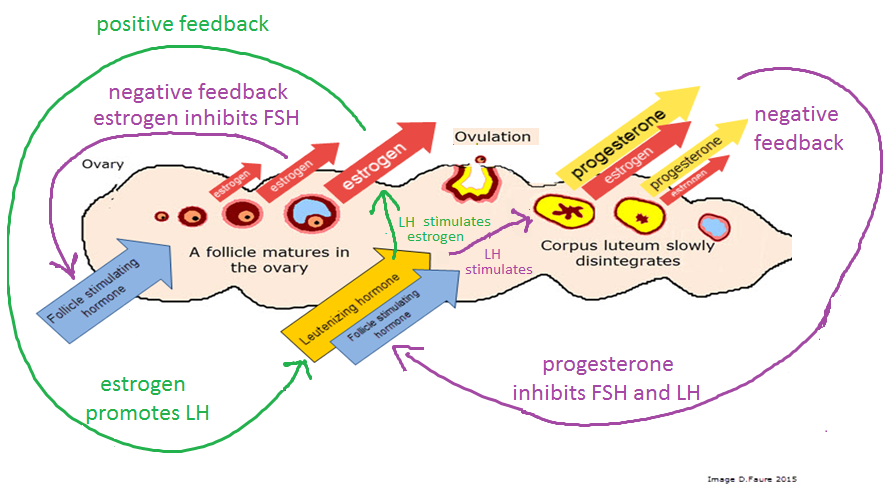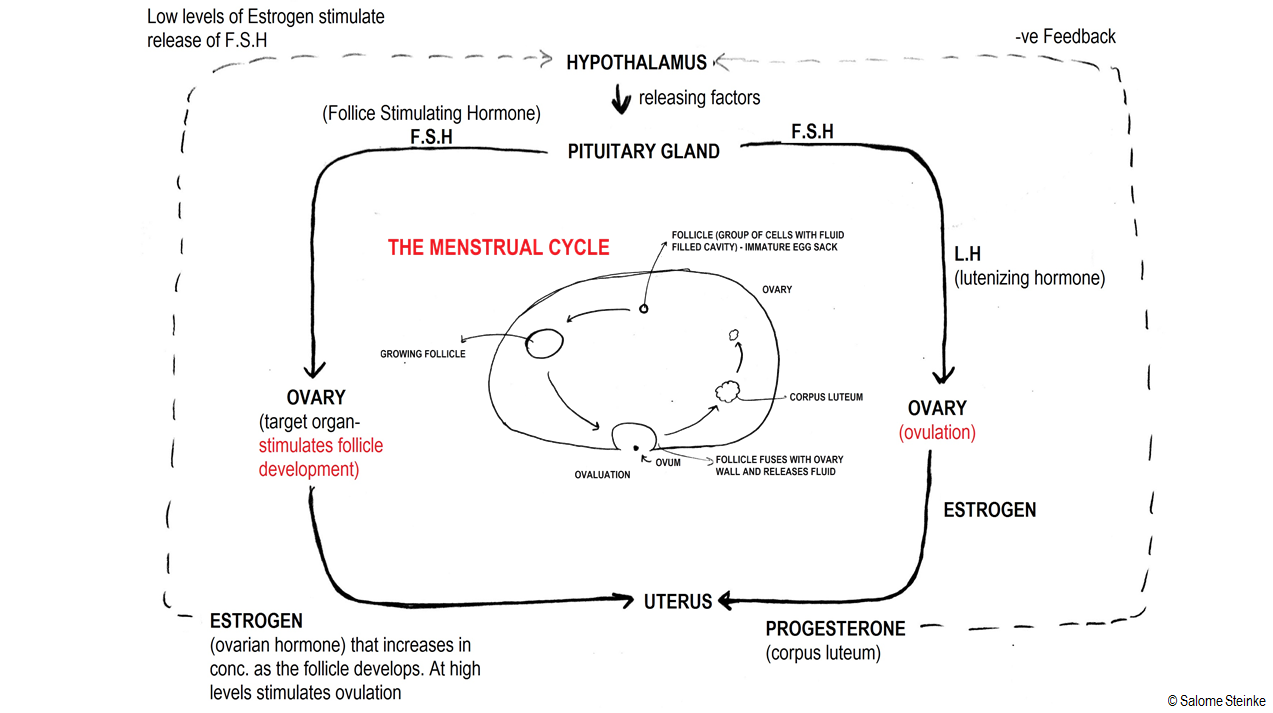Hormones and the menstrual cycle
 Students are introduced to the hormones of the menstrual cycle and their functions using a short presentation. This is followed by an activity looking at the effects the hormones have on one another and an explanation of positive and negative feedback. Students are asked to draw a diagram and then answer data based IB style questions to further consolidate learning.
Students are introduced to the hormones of the menstrual cycle and their functions using a short presentation. This is followed by an activity looking at the effects the hormones have on one another and an explanation of positive and negative feedback. Students are asked to draw a diagram and then answer data based IB style questions to further consolidate learning.
Lesson Description
Guiding Questions
How can a group of hormones cause a regular cycle
like the menstrual cycle?
What is negative feedback?
Activity 1 - Hormones of the menstrual cycle.
Introduce the hormones of the menstrual cycle with the aid of the ![]() Menstrual cycle hormone slides
Menstrual cycle hormone slides
After the introduction students complete the following activity in groups of 10.
Carrousel review activity
- Stand around the diagram with the numbered steps of menstrual cycle hormones.
- Each person takes one point and works out exactly how to explain it, in their own words.
- Take turns to explain the whole process step by step.
- Then each person moves one place clockwise, and takes the place of another student.
- One minute of discussion for each student to share their explanation with their neighbour, then repeat the exercise.
- Rotate places again, until all the students have described all the steps.
- Any student can play a 'joker' once and stay in place for one turn, if the pace is too fast.
A quick IB Style questions
Which of the following hormones are secreted by the pituitary gland, and which are secreted by cells in the ovary?
- FSH, LH, estrogen, progesterone.
...................................................................................................................................
...................................................................................................................................
Describe how the level of FSH changes during the 28 days of the menstrual cycle.
...................................................................................................................................
...................................................................................................................................
.Click the eye icon to display suggested answers.
A quick IB Style questions - Model answers
Which of the following hormones are secreted by the pituitary gland, and which are secreted by cells in the ovary?
- FSH, LH, estrogen, progesterone.
FSH and LH are made in the pituitary gland
estrogen and progesterone are made in the ovary
...................................................................................................................................
Describe how the level of FSH changes during the 28 days of the menstrual cycle.
FSH level peaks at day 14 of the cycle
FSH level is moderately high before ovulation (day 14) .
FSH is lower after ovulation.
...................................................................................................................................
Distance learning - Menstrual cycle - timeline activity
This activity is a distance learning alternative to the Carrousel review activity.
Students each produce one slide of a presentation using the details about the menstrual cycle above, ![]() Menstrual cycle hormone slides. Each student takes a slide and converts it into a timeline diagram about the process. Everyone works simultaneously and it is very easy for the teacher to watch all the slides. Simply select View, "Grid view" from the menu in Google slides and it's possible to supervise all the slides, live, in one screen. You can even edit a slide with the student if a little help is needed.
Menstrual cycle hormone slides. Each student takes a slide and converts it into a timeline diagram about the process. Everyone works simultaneously and it is very easy for the teacher to watch all the slides. Simply select View, "Grid view" from the menu in Google slides and it's possible to supervise all the slides, live, in one screen. You can even edit a slide with the student if a little help is needed.

To share the slide set with your class you will need your own Google account.
Open this link - Menstrual cycle timeline presentation,
Click; File, Make a copy, Entire presentation. Then the presentation is copied into your own Google drive
Click Share, and you can share a link with your students. Remember to give students editing rights to the slides.
At the end of the activity it's useful to present the slides to the class and ask each student to explain their slide.
If the teacher prefers students can work in small groups, and edit one slide together.
Activity 2 - Feedback - negative and positive.
Look at this quick introduction to positive and negative feedback in the menstrual cycle on the![]() Menstrual cycle feedback loop slides
Menstrual cycle feedback loop slides
Carry out research on the hormones of the menstrual cycle and produce post-it notes giving details of each hormone.
If the hormone has two effects then create two notes.
Pay particular attention to the way hormones inhibit each other, in negative feedback, or when they increase production of a hormone and cause positive feedback.
Build a flow diagram about the control of the menstrual cycle with reference to organs and feedback between hormones.
(click this icon to see some examples)
Activity 3 - Data based question
Answer the questions on the ![]() IB style questions on hormones of the menstrual cycle worksheet shown below.
IB style questions on hormones of the menstrual cycle worksheet shown below.
Teacher's notes
Activity 1 is designed to focus first on the functions of the hormones in the menstrual cycle. There is no mention on inhibition of other hormones, which is the focus in activity two.
The carrousel review activity is a great way to get students talking about the process.
First they have to learn one single detail. Don't allow use of notes, there won't be any notes in the IB exams.
The second stage of the activity involves students moving one place down the chain, the last person becomes the first.
Give the students time to learn from each other, to ensure they understand what they have to say and can remember this next step. Even if it seems like it is taking some time, remember in the discussion they are all explaining the biology to each other and trying to learn another detail, so it isn't time wasted.
Sometimes there is a timid student who is daunted by the task. Allow this student one 'pass' so they don't have to change places. I sometime select the starting places for students depending on the difficulty of the explanations, which helps to differentiate too.
Distance learning activity on menstrual cycle
This activity is an alternative to the carrousel review activity. Students can work at home and they produce a single slide to summarise the roles of the hormones and the details of the cycle. I have shared a set of Google slides but they are read only. To share them with students you will need to make a copy in your own Google account. It would be possible to download the slides as powerpoint and do this same activity in onedrive, or print the slides into Onenote, and put this page into the collaboration space to work on in simultaneously.
Activity 2 focuses on the interactions between hormones.
The students work in small groups of 3 or 4 to research the inhibitory effects of hormones on each other, or on the development of different parts of the system. Then with the details written on cards or post-it notes they try to construct a "flow diagram" of the interactions in the menstrual cycle.
If there are unanswered questions in one group try to get other students to help answer these questions. Send an 'envoy'.
Activity 3 is a summative activity which also provides students with a set of notes to take away.
There are some model answers to activity 3 here: IB style questions - hormones & menstrual cycle model answers

 IB Docs (2) Team
IB Docs (2) Team


